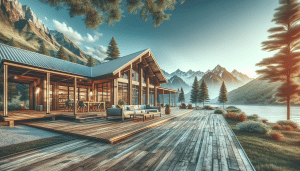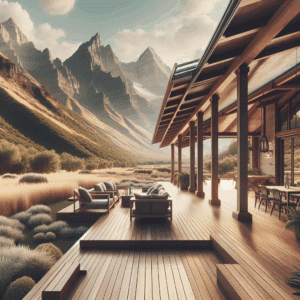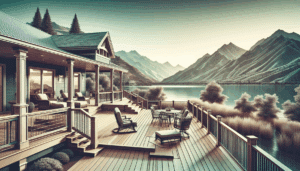Picture this: warm Orem sunshine, a cool breeze off Utah Lake, and you, coffee in hand, stepping onto a deck that just feels right. That’s the dream. But the path to a safe, beautiful deck runs through one crucial step—choosing the right builder. Ask better questions, get better results. So here are the 10 questions homeowners in and around Orem should ask any contractor before a single footing is poured. And yes, you’ll see how Utah County Decks answers them, too—plain and simple.
Table of Contents
- Why the questions matter more than the price tag
- 1) Are you licensed, insured, and familiar with Orem permits?
- 2) What Decking materials do you recommend—and why?
- 3) Can I see local projects and talk to recent clients?
- 4) How do you design for shade, privacy, and views?
- 5) What’s your process and timeline—start to finish?
- 6) Who’s on site daily, and how do you protect our property?
- 7) How do you handle structure—footings, framing, and code?
- 8) What’s included in the quote—and what’s not?
- 9) What warranty do you offer, and what maintenance should I expect?
- 10) How do you handle slopes, drainage, and awkward yards?
- Bonus quick-hit questions worth asking
- What does a deck cost in Orem?
- How you’ll know you found the right builder
- Ask smarter questions. Get a better deck.
Why the questions matter more than the price tag
A deck is not a porch swing. It’s a structure that must handle Utah’s freeze–thaw cycles, surprise snow in April, and July UV that can fade anything not built for it. In Orem, the right builder understands local code, snow loads, and HOA quirks. The right answers help you compare apples to apples and avoid the “we’ll figure it out later” trap.
Here’s the thing: the lowest bid can look great for a minute. But missing flashing, shallow footings, or cheap fasteners? That gets expensive. Smart questions protect your budget and your peace of mind.
1) Are you licensed, insured, and familiar with Orem permits?
This one sets the tone. You want a licensed contractor who carries general liability insurance and workers’ comp. Ask for proof. Don’t feel awkward—reputable builders expect it.
In Orem, permits run through the Orem Building Services Department. Inspectors check footings, framing, sometimes Railing height and stairs. Your builder should handle the permit packet, engineering (if needed), and inspections. If they shrug at code talk, that’s a red flag.
What we do at Utah County Decks: We’re licensed, insured, and we handle the whole permit process, from drawings to final inspection. Honestly, that’s our job, not yours.
2) What Decking materials do you recommend—and why?
There’s no single “best” material for everyone. There’s what’s right for your budget, sun exposure, and maintenance style.
Consider the big categories locals ask for:
- Cedar or Redwood: Warm look and feel. Needs sealing or staining. Great for that classic Utah look. Lower upfront cost; more upkeep.
- Pressure-Treated Pine: Budget-friendly, rugged, takes stain. Watch for movement with our dry climate.
- Composite Decking (brands like Trex, TimberTech, Fiberon): Fade- and stain-resistant, low maintenance. Ideal for the strong sun we get along the Wasatch Front.
- PVC Decking (e.g., Azek): Very low maintenance, handles moisture well. Good near sprinklers and snow melt zones.
We also think through fasteners. Hidden clips look clean and reduce snags. Face screws with color-matched plugs can be great for stairs and picture-frame borders. Small details, big difference.
| Material | Maintenance | Typical Lifespan |
|---|---|---|
| Cedar/Redwood | Stain/seal every 1–2 years | 10–15 years deck surface |
| Pressure-Treated | Stain/seal every 1–2 years | 10–15 years deck surface |
| Composite/PVC | Soap-and-water cleaning | 25+ years deck surface |
Numbers vary based on exposure, care, and traffic—south-facing decks in Orem take more sun, so materials matter.
Ask your builder to explain why they’re recommending a certain brand or board profile for your yard. Let me explain: the right choice is the one that fits your lifestyle. If you hate maintenance, say so. If you love the look of real wood, we’ll plan a care routine that keeps it gorgeous.
3) Can I see local projects and talk to recent clients?
Portfolio photos are great, but real decks tell the story. Ask for drive-by addresses in Orem, Provo, Vineyard, or Lehi. Look at stair treads, railings, gate latches, and under-deck framing if you can. Ask if you can speak with a recent client. A five-minute chat can calm nerves.
At Utah County Decks, we’re proud to share local references. You’ll see how our decks hold up through a couple of winters and a wildfire smoke summer or two. You know what? That kind of transparency shows you more than any ad.
4) How do you design for shade, privacy, and views?
A deck should fit your life, not just your house. We map the sun path, the neighbor’s second-story window, and the killer view of Timpanogos. Then we plan features that solve problems:
- Pergolas and shade sails for those hot 3–6 pm hours.
- Privacy screens that block sightlines but still let air move.
- Railing choices (cable, glass, or pickets) that balance safety with views.
- Lighting for stairs and borders so evenings feel relaxed, not risky.
Small tweak, big comfort: shifting a stair run or adding a 2-foot bump-out for a grill can change how you use the whole space. That’s design that listens.
5) What’s your process and timeline—start to finish?
Every builder has a rhythm. Ask for theirs in simple terms. A clear process prevents confusion when the crew and the inspector show up on the same day.
Here’s ours:
- Consult: We visit your home, measure, discuss goals and must-haves.
- Design: Sketches or 3D. We refine layout, materials, railing, and lighting.
- Proposal: Transparent pricing with line items. No mystery fees.
- Permits: We handle paperwork with Orem.
- Build: Site protection, footings, framing, decking, railings, details.
- Walkthrough: Punch list and warranty info.
Timelines vary with weather and scope, but a typical single-level deck runs 1–2 weeks once materials are on site. Multi-level or covered decks take longer. Snow happens; we plan for it.
6) Who’s on site daily, and how do you protect our property?
It’s fair to ask who’s swinging hammers at your house. Will you meet a project lead? Are subs involved? What hours do they keep?
We assign a daily point person. They check in, review milestones, and handle questions. Protection matters too:
- Landscape care with plywood paths and tarps where needed.
- Debris control with daily cleanups and magnet sweeps for screws.
- Safety around pets and kids—temporary gates, clear barriers, covered holes.
It sounds small. It isn’t. A clean job site makes for a safer, faster build.
7) How do you handle structure—footings, framing, and code?
This is where decks succeed or fail. Ask specifics:
- Footings: Depth below frost line for Utah County and proper diameter. We often go 30 inches or more and enlarge for hot tubs.
- Framing: Pressure-treated lumber, joist spacing matched to your decking—12 or 16 inches on center depending on manufacturer specs.
- Hardware: Hot-dip galvanized or stainless for longevity. No shortcuts.
- Ledger flashing: Proper waterproofing against the house—this is non-negotiable.
- Snow load: We design for local loads; it’s Utah, not vacation-land.
Some yards do great with helical piers, especially near existing concrete or tricky soils. We’ll recommend them if they’re a better fit. If your builder dodges technical questions, press a little. You deserve straight answers.
8) What’s included in the quote—and what’s not?
The prettiest proposal is the one that tells the whole story. Ask for line-item clarity so you know exactly what your money buys.
Look for:
- Demo and haul-off of the old deck, if any.
- Permits and inspections included, not left to you.
- Electrical for lighting or outlets. Gas lines if you’re adding a grill or fire feature.
- Railing type and count, gate hardware, and stair lights.
- Under-deck work: skirting, storage doors, drainage systems if needed.
- Finishes: stain/seal for wood decks, plus brand and color.
Ask how change orders are handled. Sometimes you’ll add a cocktail rail or upgrade post caps midstream. That’s normal—just make sure costs are documented.
9) What warranty do you offer, and what maintenance should I expect?
A good deck should be easy to own. Builders typically offer a labor warranty; manufacturers cover materials. The details matter.
What we cover:
- Labor warranty with clear terms in writing.
- Manufacturer support for composite decking like Trex, TimberTech, and Fiberon.
- Care guide with seasonal tips—simple things like gentle cleaning and snow shoveling with a plastic blade.
Wood needs stain or seal. Composites need soap, water, and a soft brush. We’ll tell you what’s overkill and what actually helps.
10) How do you handle slopes, drainage, and awkward yards?
Orem yards can slope more than you think. Add sprinklers, clay soil, and runoff from a neighbor’s lot and you’ve got a small puzzle. Your builder should talk drainage and grading without flinching.
Good solutions include:
- Deeper footings or helical piers on slopes.
- French drains or swales that steer water away from the house.
- Under-deck drainage systems to create dry storage or a cozy patio below.
- Stair planning that feels natural—not a ladder you dread each winter.
It’s funny—a deck can hide yard challenges or make them worse. We prefer the first one.
Bonus quick-hit questions worth asking
Sometimes the small asks make a big difference.
- Lighting: Can we add step and post lighting now, with wiring hidden?
- Hot tubs: Will the structure and electrical be sized for it?
- Railing style: Cable, glass, or metal balusters—what fits our view and budget?
- Child and pet safety: Gates, baluster spacing, latch types.
- Accessibility: Wider stairs, lower risers, continuous handrails.
- Future add-ons: Can you rough-in for a pergola later?
What does a deck cost in Orem?
Every project is its own thing, but here’s a friendly range based on recent builds around Utah County. Keep in mind: design, access, and features push numbers up or down.
- Pressure-treated or cedar single-level decks: often in the lower price range for the same square footage.
- Composite decking with aluminum or cable rail: mid to higher range depending on brand and layout.
- Covers, pergolas, or under-deck drainage: add cost but extend how much you use the space.
We price line by line so you can adjust features without guessing. Change the railing, tweak the stairs, swap post caps—see the numbers, make the call.
How you’ll know you found the right builder
You’ll feel it in the way they talk about your yard. Clear, not pushy. Curious, not scripted. They’ll explain code without condescension and suggest smart alternatives when the internet idea doesn’t fit your lot.
Signs you’re in good hands:
- Transparent communication and daily updates.
- Pride in craft you can see in corners, cuts, and clean lines.
- Respect for your time and property—arrivals, cleanups, and polite crews.
- Local know-how around Orem permits, soil, snow, and sun.
It’s your home. The builder should feel like a partner, not a gamble.
Ask smarter questions. Get a better deck.
If you’re planning a deck in Orem or nearby, we’d love to help you compare options and map out a design that fits your life. Utah County Decks builds wood, composite decking, and covered outdoor spaces across Utah County—with permits handled, timelines respected, and details fussed over.
Call us at 801-406-3726 to talk through your project, or tap here to Request a Free Quote from Utah County Decks”>Request a Free Quote. We’ll answer your questions, bring samples, and give you a clear, fair proposal. No pressure—just straightforward guidance and a deck you’ll actually use, morning to night.



